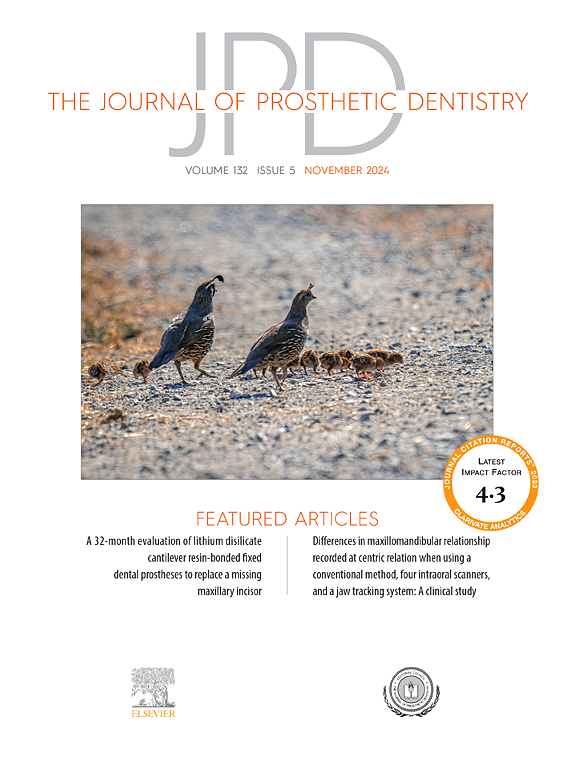最近引入的单一阴影复合树脂与多阴影复合树脂的颜色调节潜力的仪器和视觉评估。
IF 4.8
2区 医学
Q1 DENTISTRY, ORAL SURGERY & MEDICINE
引用次数: 0
摘要
问题陈述:单色调复合树脂通过提供窄范围的颜色,但能够模拟所有色调,简化了色调选择过程。然而,新开发的单色复合树脂的变色能力证据有限。目的:本体外研究的目的是评估最近引入的单一阴影复合树脂与传统多阴影复合树脂在不同背景色下的仪器颜色调节潜力(CAP-I)和视觉颜色调节潜力。材料和方法:测试了四种多遮光层复合树脂(Spectrum TPH3、Beautifil II、Clearfil AP-X和Gradia Direct)和一种单遮光层合成树脂(Charisma Diamond One)。选择相同复合树脂(Filtek Z350XT)的四种基本色调(A1、A2、A3和A3.5)作为不同的背景色。制备了所有测试材料和基材的双试样(具有填充有内部测试材料的内部孔的外部基材)和单个试样(每组n=6)。光谱反射率值是通过使用光谱辐射计获得的。利用CIEDE2000和RTPCIEDE2000公式计算了色差(ΔE00)和相对透光性参数(RTP)。颜色匹配的视觉评分由独立观察者进行。根据ΔE00和视觉评分计算CAP-I和CAP-V值。结果:CAP-I和CAP-V受复合树脂类型、背景颜色、颜色等因素的影响显著,结论:调色潜力取决于材料类型和背景颜色。Charisma Diamond One表现出最高的调色潜力和最明显的变色能力。本文章由计算机程序翻译,如有差异,请以英文原文为准。
Instrumental and visual evaluation of the color adjustment potential of a recently introduced single‑shade composite resin versus multishade composite resins
Statement of problem
Single-shade composite resins simplify the process of shade selection by providing a narrow range of color but the ability to simulate all shades. However, evidence is limited for the color shifting ability of a newly developed single‑shade composite resin.
Purpose
The purpose of this in vitro study was to evaluate the instrumental color adjustment potential (CAP-I) and visual color adjustment potential (CAP-V) of a recently introduced single-shade composite resin compared with conventional multishade composite resins against different background colors.
Material and methods
Four multishade composite resins (Spectrum TPH3, Beautifil II, Clearfil AP-X, and Gradia Direct) and a single-shade composite resin (Charisma Diamond One) were tested. Four base shades (A1, A2, A3, and A3.5) of the same composite resin (Filtek Z350XT) were selected as different background colors. Dual specimens (an outer base material with an inner hole filled with inner test material) and single specimens of all test and base materials were prepared (n=6 per group). Spectral reflectance values were obtained by using a spectroradiometer. The color difference (ΔE00) and relative translucency parameter (RTP) were calculated by using the CIEDE2000 and RTPCIEDE2000 formula. Visual scoring of color matching was performed by independent observers. The CAP-I and CAP-V values were calculated according to ΔE00 and visual scoring. Analysis of variance (ANOVA) was used for statistical analysis (α=.05).
Results
CAP-I and CAP-V were significantly affected by composite resin type, background color, and their interaction (P<.001). Positive CAP-I and CAP-V values were found for the majority of test materials. Charisma Diamond One exhibited the highest CAP-I value under all background colors, the highest CAP-V value under most background colors, and the significantly highest RTP value (P<.001).
Conclusions
The color adjustment potential was dependent on the material type and background color. Charisma Diamond One exhibited the highest color adjustment potential and the most pronounced color shifting ability.
求助全文
通过发布文献求助,成功后即可免费获取论文全文。
去求助
来源期刊

Journal of Prosthetic Dentistry
医学-牙科与口腔外科
CiteScore
7.00
自引率
13.00%
发文量
599
审稿时长
69 days
期刊介绍:
The Journal of Prosthetic Dentistry is the leading professional journal devoted exclusively to prosthetic and restorative dentistry. The Journal is the official publication for 24 leading U.S. international prosthodontic organizations. The monthly publication features timely, original peer-reviewed articles on the newest techniques, dental materials, and research findings. The Journal serves prosthodontists and dentists in advanced practice, and features color photos that illustrate many step-by-step procedures. The Journal of Prosthetic Dentistry is included in Index Medicus and CINAHL.
 求助内容:
求助内容: 应助结果提醒方式:
应助结果提醒方式:


